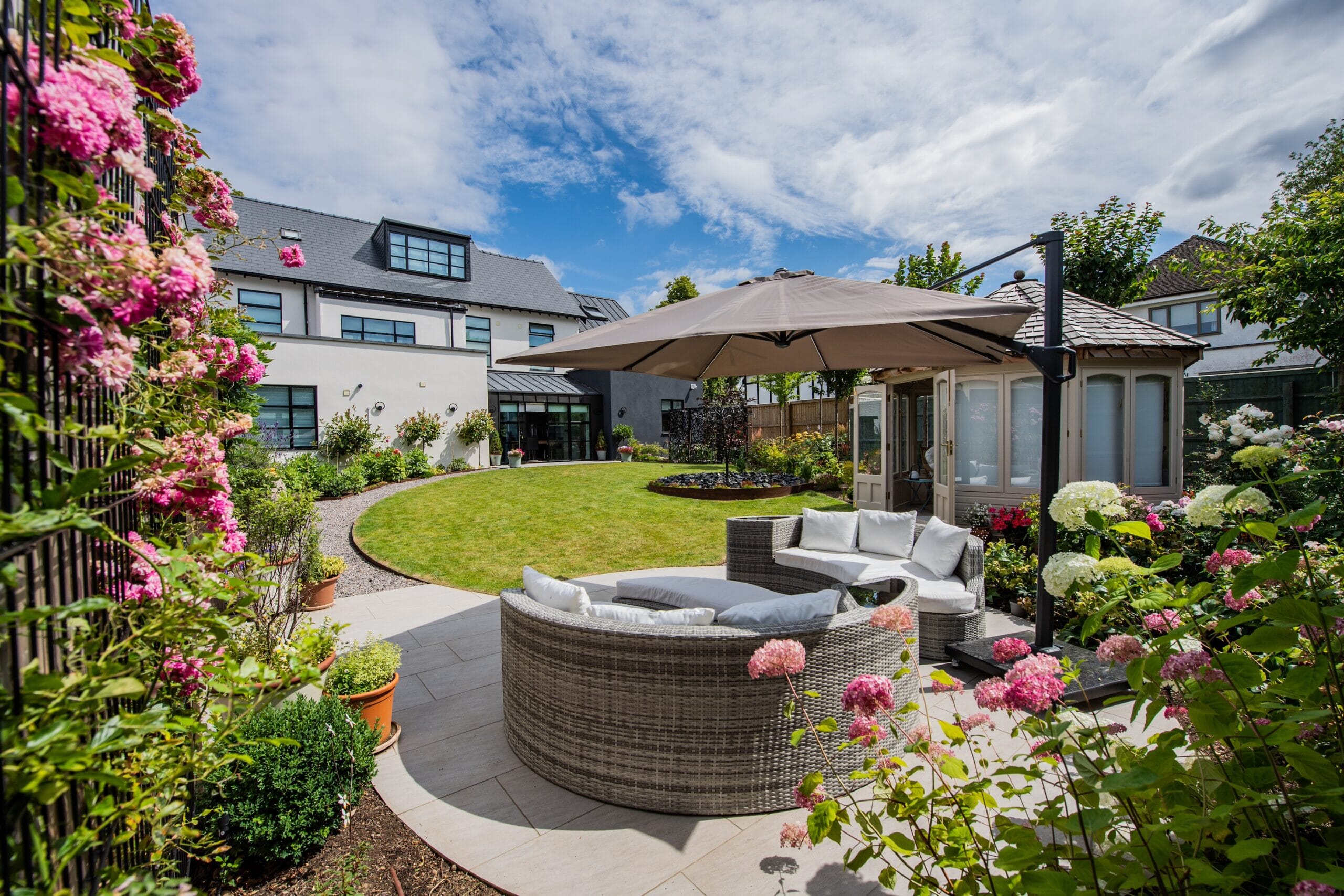A garden without a patio is a bit like a home without a kitchen – it’s the heart of your outdoor space, whether that’s an entertaining area where people come together to eat, drink and connect or you retreat for some quiet time. Whatever its use, your patio will be a much used, much loved part of the garden, so when you design a garden patio, it’s important to get it right.
In this guide, Sam Clark, Cotswold Landscape Designer at Gardens by Keltie & Clark, gives his views on how to design a patio area that fits your property and lifestyle, and discusses patio paving ideas, including the pros and cons of using porcelain and natural stone.
One of the first things to consider when thinking about a patio design is how you envisage yourself using the space. Is it going to be for entertaining large crowds – in which case you’ll want a space that can accommodate a good sized table and chairs, with enough space for people to walk around freely as well as incorporating some form of shade.
Or will it be a more contemplative area, somewhere to kick back and read under the summer sun? For that you might want to have an outdoor sofa in a spot that’s quiet and cosy, surrounded by beautiful, calming planting.
What you want to use your patio area for will determine the type of patio paving you choose, where in your garden you should position your patio, and also the planting design that surrounds the patio area.
Once you have decided on how you will use your patio and where it might be located within the garden, the next question is to think about patio paving ideas. Choosing the right product will depend on a number of factors, but the starting point should always be how in keeping do you want it to be with your property? If you have a traditional Grade II listed Cotswold manor house, for example, you might want to look at natural stone that’s been locally quarried and that matches the style and period of your property. However, today there is also a fantastic range of impressive porcelain patio paving that can resemble natural stone or which can be used to create a more modern, sleek patio design.

When it comes to patio paving ideas, both porcelain and stone offer advantages and disadvantages.
1.Consistency: porcelain is a printed product so it is easy to achieve consistency in design, colour and texture. That means you should be able to match tiles if you want to build your patio area in different stages. The only consideration is to be aware that if a printing process changes, then there may be slight variations in design.
2. Huge choice: because they are printed, porcelain patio tiles can be created in a myriad of styles and colours. They are a great choice if you want a sleek, minimal design for your patio, but there is also a great range of porcelain paving tiles that are designed to look like natural materials, for example, porcelain tiles that resemble wooden floorboards or riven natural stone.
3. Practicality: as porcelain is made from clay which is fired at high temperatures under pressure, it is an extremely durable and long-lasting material which doesn’t chip or crack easily. As it is not porous, it is very resistant to water, sun damage and food and drink stains, which makes it ideal for a space where there is a lot of food or heavy traffic.
1.Appearance: as a natural product, stone has variations in colour, pattern and texture, making each paving slab completely unique. The natural beauty of stone, with its organic textures and earthy tones, brings character and warmth to a space, perfect for maintaining the more rustic exteriors of listed Cotswolds properties.
2. Versatility: while stone is mainly used for paving, it can also be used to create complementary garden patio features, such as steps, uprisers, plinths, copings and even bench seating. By using the same stone for all these details, garden designers can create a patio space that feels harmonious and with a good sense of flow.
3. Sustainability: some people choose to use stone that is quarried locally, not just because there is a good chance that the stone will match the exterior of their property, but also because of the reduced carbon footprint. To reduce transport miles for a patio design in a Cotswold garden, Forest of Dean Stone is a good local quarry that also produces natural sandstone ethically and sustainably.
Whether you choose porcelain or natural stone paving slabs, your patio will only be as good as the base it is laid on. If you want your patio to last, then it is important not to skimp on the foundation. Here’s how:
The most important element of creating a stable patio that will stand the test of time is to make sure the foundations are secure. That means understanding what type of soil or clay you are working on and taking measures to account for this. For example, clay heave can be an issue in some Cotswolds gardens, a process where the clay soil takes in water and expands causing an upward movement that can cause structural damage to patios and other landscape features.
Ideally, patio slabs should be laid on a stable sub-base, such as a concrete slab or good depth of hardcore to help maintain stability over time. If the patio slabs are laid onto not a suitable base, then they will shift over time and even crack.
It is important to incorporate a slight slope or fall into your patio so that water can drain away naturally, otherwise you will very quickly find you have created a swimming pool rather than a patio! The fall should be angled away from your house or any walls.
A geotextile membrane is a piece of material that can help to stabilise the ground before you lay your patio slabs. It helps to prevent sinking and rutting by separating the soil from the aggregate and spreading the load. It can be a good idea to include a geotextile membrane in your patio design as this helps preserve the lifespan of your patio.
Once your patio is laid and set, it is important to maintain it. If you don’t look after your patio, it can soon slip into disrepair, especially over the winter months. If you have used natural stone patio slabs, these will need regular re-sealing to keep them looking their best and to protect them from weather damage and further staining.
If your patio has gone a bit green over winter, it is easy to bring it back to life. Jet-washing with a pressure hose is the simplest way to clean patio stone and porcelain patio tiles. If you need something a bit stronger, you could use a mild detergent, and a good way to dilute stains is to use a vinegar solution of vinegar mixed with water. Keep your patio properly maintained and you will be able to enjoy it for years to come.
Now is the ideal time to start thinking about how to design a garden patio so that you can enjoy your new patio area next summer. If you have any questions on how to design a patio layout or you need help with how to lay a patio, then please get in touch with our team of Cotswold garden designers and landscapers. We can take care of the whole process from the design of your patio area to the build and installation, or anything in between.


